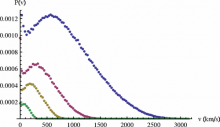
Abstract
We study the statistical distributions of the spins of generic black-hole binaries during the inspiral and merger, as well as the distributions of the remnant mass, spin, and recoil velocity. For the inspiral regime, we start with a random uniform distribution of spin directions S1 and S2 and magnitudes S1=S2=0.97 for different mass ratios. Starting from a fiducial initial separation of ri=50m, we perform 3.5PN evolutions down to rf=5m. At this final fiducial separation, we compute the angular distribution of the spins with respect to the final orbital angular momentum, L. We perform 16^4 simulations for six mass ratios between q=1 and q=1/16 and compute the distribution of the angles between L and Delta and L and S, directly related to recoil velocities and total angular momentum. We find a small but statistically significant bias of the distribution towards counter-alignment of both scalar products. To study the merger of black-hole binaries, we turn to full numerical techniques. We introduce empirical formulae to describe the final remnant black hole mass, spin, and recoil velocity for merging black-hole binaries with arbitrary mass ratios and spins. We then evaluate those formulae for randomly chosen directions of the individual spins and magnitudes as well as the binary's mass ratio. We found that the magnitude of the recoil velocity distribution decays as P(v) \exp(-v/2500km/s), <v>=630km/s, and sqrt{<v^2> - <v>^2}= 534km/s, leading to a 23% probability of recoils larger than 1000km/s, and a highly peaked angular distribution along the final orbital axis. The final black-hole spin magnitude show a universal distribution highly peaked at Sf/mf^2=0.73 and a 25 degrees misalignment with respect to the final orbital angular momentum.